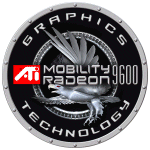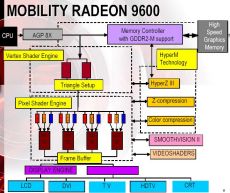The IGP 7000M will serve the low end of ATI's notebook graphics range, and M9+ will serve the mainstream. As the codename suggests, M9+ is an updated version of M9 - as M9 corresponds to the Radeon 9000 desktop part, so M9+ corresponds to Radeon 9200, which is basically the same, with inclusive support for AGP8X. Beyond AGP8X, Mobility Radeon 9200 will benefit from slightly higher core speeds over its predecessor in an effort to boost performance. The 9200 basically replaces 9000, but also moves into the mainstream performance segment, to make way for M10....

M10 is the mobile variant of RV350. Known as Mobility Radeon 9600, the Radeon 9600, like its desktop counterpart, brings ATI's DX9 featureset to the laptop by taking the R300 core, enhancing it in some areas, cutting back on the Shader pipelines (two Vertex Shaders and 4 Pixel Shader pipelines) and placing it on TSMC's 130nm silicon process. Although M10/RV350 doesn't feature R350's F-Buffer technology, it has had its FSAA tweaked for better performance.
* Note: it's our understanding that the Pixel Shader element of RV350/M10 is still at FP24 precision.
As with its desktop counterpart, Mobility Radeon 9600 will ship in two variants, Mobility Radeon 9600 and 9600 PRO. They will be differentiated by their clockspeeds, with the 9600 up to 300MHz core clock speed, and the 9600 PRO up to 350MHz core speed. Despite the increase in speed the smaller silicon process allows them the maintain a low operating voltage of just 1.0V, which in turn means that despite the increased complexity, operating frequency, and overall performance the power draw remains equivalent to prior generations.
Another important element that makes up for performance is that of the memory used. M10 can operate with DDR RAM, and although it won't become immediately available, ATI have worked with Elpida to create GDDR-2M memory specifically for notebooks. GDDR-2M was based on the DDR-2 memory specification, but includes On-Die Termination and data inversion technologies which enable the memory to run at high speeds but still maintain acceptable levels of power consumption for notebooks. Elpida are currently sampling this memory type at 350MHz, 400MHz and 450MHz speeds which, as they are DDR-2, gives a maximum equivalent operating rate of 900MHz in a notebook. ATI will also offer a number of memory configurations, with the notebook manufacturer being able to choose from fully external memory, 32MB on the package, 64MB on the package, or a full 128MB on a single package - which is the equivalent of an entire, fully featured 128MB DX9 graphics card in about a 3.5cm x 3.5cm sized area!

Like NVIDIA, ATI will ship a new version of its PowerPlay power regulation suite, bringing it to PowerPlay4; but possibly one of the most interesting features to notebook gamers is that of 'Overdrive'. M10 has a Thermal Sensor integrated into the chip that will detect its operating temperature at all times and ATI has designed this to control clocks speeds. The M10 parts will always (assuming a suitable power setting is selected for it) operate at a base core speed, yet ATI will let notebook manufactures also select a ceiling temperature limit for the part - if the ambient conditions that you are using allow it and Overdrive is enabled, Overdrive will automatically overclock the chip until it operates at the ceiling temperature. The clock speeds are then adjusted to maintain that temperature. This means that the 3D performance will never be less than what's achieved with the default clock settings, but can be greater dependant on what temperature the notebook, and hence graphics chip, is operating at - run a game in a hot room and you'll get your normal performance, run it in a cooler room and you could end up with a performance increase.
As ever, ATI are also paying keen attention to the video elements of Mobility Radeon 9600. As we've seen with the rest of the 9000 range Mobility Radeon 9600 has hardware MPEG/DVD decoding, as well as 'SLIPSTREAM', ATI's stream video deblocking tool. In conjunction with hardware MPEG encoding functionality ATI can also provide PVR time shifting software for the recording of video. ATI say that some notebook manufacturers are actually shipping with an internal TV-Tuner already, but Mobility Radeon 9600 also has a capture port that can be included with the notebooks. Finally, along with all the standard notebook, VGA, and TV displays Radeon Mobility 9600 will also support wide aspect LCD panels and HDTV - ATI already provide a DVI to HDTV dongle, and this can be used with notebooks that are configured with Mobility Radeon 9600.
ATI's R300 platform has proven to be a very robust solution in all its forms so far, and this looks like it will extend to the mobile platform.
Related PR:
- ATI Unleashes the MOBILITY RADEON 9600 Family of Mobile VPUs
- Elpida Memory's 32-bit Wide DDR2 for Notebook Graphics
- ATI Unveils MOBILITY RADEON 7000 IGP Integrated Graphics
- ATI 15 Notebook Design Wins Featuring Intel Centrino
Conclusion
Both ATI and NVIDIA have been matching each other release for release over the past few weeks, and this has extended into CeBit with the virtual simultaneous announcements of their mobile parts. In truth I wasn't expecting the Mobility Radeon 9600's announcement today as I was still under the impression that it was NDA'ed until May, a timeframe when ATI expects to actually see notebook solutions in the channel equipped with Mobility Radeon 9600s. So why the announcement now? Well, partly it may be due to NVIDIA's announcement, but as NV34 and NV31 are only just beginning to ramp up, NVIDIA are likely to see a similar time period before any actual notebook solutions with these new mobile variants are available. But it's more likely to do with Intel Centrino platform. Intel made a big push of Centrino at CeBit, and there's been lots of notebook vendors announcing solutions. So while the notebook sector is 'hot' from these announcements, it becomes a good time for the graphics boys to hop on the bandwagon.
As for the show itself, as I said I really could have done with more time there. Even in the short time I did have I managed to sit down with a few people and chat to a number of board vendors we've not seen at B3D before. However, should I be in an opportunity to go next year, it will definitely be for a longer period of time.

